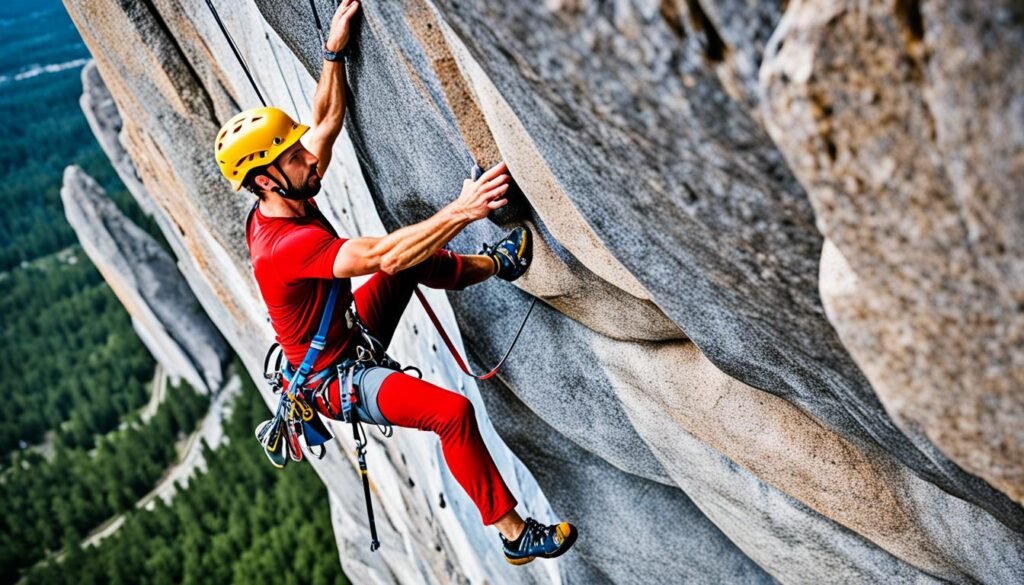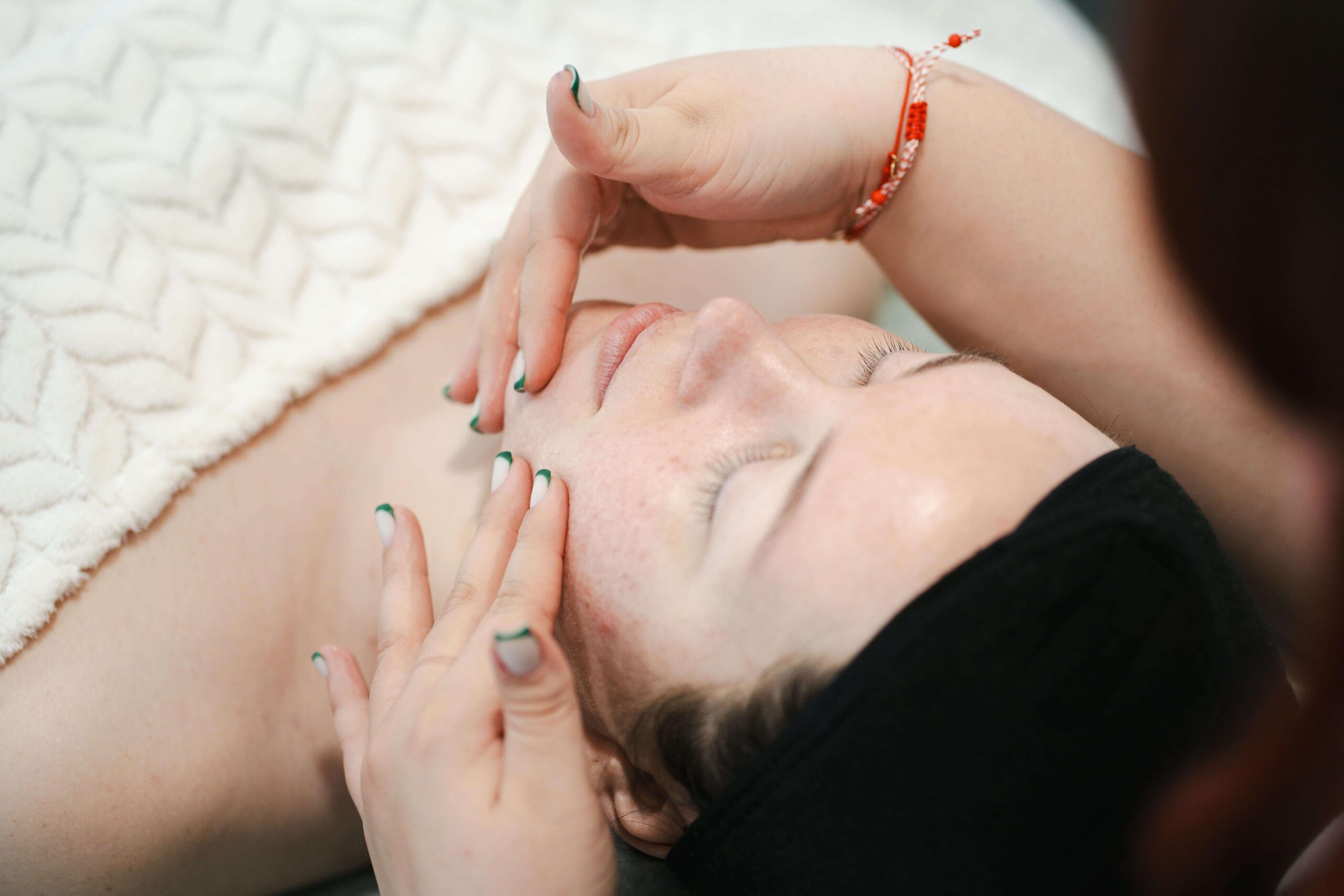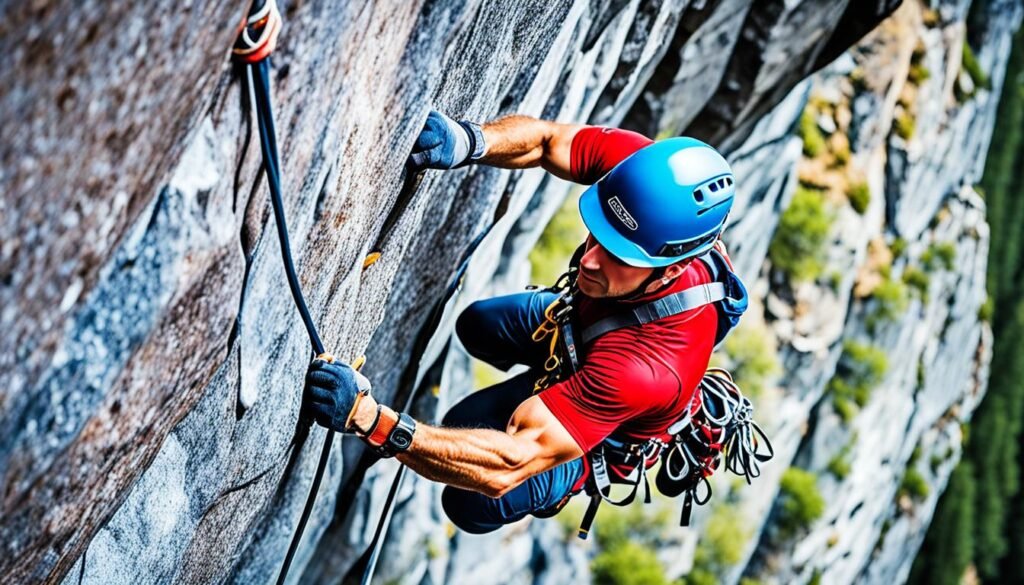Rock climbing is an exciting outdoor adventure that tests your body and mind. It doesn’t matter if you’re new or have been climbing for years. Making safety your top priority is key to having a fun and safe time on the rocks. This guide will give you important rock climbing safety tips. These tips will help you climb with confidence and reduce risks at every step.
Table of Contents
ToggleKey Takeaways
- Invest in high-quality rock climbing equipment and check it often for damage or wear.
- Learn climbing techniques like how to place your feet and position your body for better control and balance.
- Get to know anchors and protection to make sure you’re safe going up and coming down.
- Understand lead climbing safety protocols to handle risks when you’re climbing more challenging routes.
- Take good care of your rock climbing gear by checking it regularly and keeping it in good shape.
Mastering Rock Climbing Safety
Starting a rock climbing adventure means learning safety protocols well. It’s key for a fun and safe time. For beginners, knowing rock climbing safety tips is vital. It helps reduce risks and boost your fun on the rocks.
Essential Guidelines for Beginners
Beginners should get to know the essential safety guidelines. This means picking the right climbing gear, learning climbing techniques, and knowing the dangers. Learning from experts or instructors can improve your climbing skills and keep you safe.
Mitigating Risks and Ensuring a Safe Climb
Rock climbing has risks, but you can manage them with care. Here are some ways to lower the risks:
- Do partner checks before and during the climb
- Make sure your climbing system is secure
- Stick to climbs that match your skill level
- Keep clear communication with your partner
- Plan a safe descent from the rock
Putting safety first and following rock climbing safety tips lets you enjoy the sport safely. This way, you can have fun without worrying about accidents or injuries.
“Safety should always be the top priority when rock climbing. By mastering the essential guidelines and mitigating risks, you can climb with confidence and focus on the adventure ahead.”
Selecting the Right Rock Climbing Gear
Choosing the right gear for rock climbing is key to your safety and how well you perform. A climbing harness is a must-have. It keeps you safe and supported during your climbs.
Harnesses: Comfortable and Secure Fit
A good climbing harness should be comfy and secure. This lets you focus on climbing without any discomfort. Here are some things to think about when picking a harness:
- Adjustability: Choose a harness with many adjustment points. This way, you can get the perfect fit for comfort and support.
- Padding: Padded leg loops and a waist belt prevent rubbing and spread out the weight. This makes climbing for a long time more comfortable.
- Gear Loops: Having lots of gear loops means you can carry your rock climbing equipment like carabiners and chalk bag easily.
- Durability: Pick a harness made from strong materials. It should last a long time and handle the tough conditions of climbing.
A well-fitting climbing harness can really change your climbing experience. It makes you safer and more comfortable.
| Feature | Importance |
|---|---|
| Adjustability | Allows for a customized fit for optimal comfort and support. |
| Padding | Prevents chafing and distributes weight evenly for long climbs. |
| Gear Loops | Provides storage for rock climbing gear, such as carabiners and quickdraws. |
| Durability | Ensures the climbing harness can withstand frequent use and exposure to the elements. |
Rock Climbing Safety Tips
Rock climbing is thrilling, but safety comes first. These rock climbing safety tips will help you climb safely and have fun. They are useful for both new and experienced climbers.
Before you start climbing, check your rock climbing gear carefully. Make sure your harness, carabiners, and ropes are in good shape. Also, check that all knots are secure. Following outdoor safety rules is key to a successful climb.
- Get to know the climbing area and watch out for dangers like loose rocks or bad handholds.
- Talk to your climbing partner and agree on signals. Always keep an eye on each other’s safety.
- Always touch three parts of the rock with your hands or feet to stay balanced and safe.
- Drink water and rest when you need to. Being tired can make you more likely to fall.
- Keep the climbing area clean by taking your trash with you. This helps protect the environment for others.
Using these rock climbing safety tips will make you more confident and skilled. Focus on safety with each climb, and you’ll have an amazing time.
Proper Climbing Techniques
Learning the right climbing techniques is key for your safety and efficiency on the rock wall. We’ll cover the importance of good footwork and body positioning skills. These skills help you move through the climbing terrain with confidence and control.
Footwork and Body Positioning
Good footwork is the base of rock climbing skills. It’s about placing your feet in the right spots, balancing well, and spreading your weight right. Focus on using the whole surface of your foot for better grip and stability.
Your body positioning is also crucial. Keep your center of gravity low, your hips near the wall, and your weight spread out over your limbs. This keeps you in control and lowers the chance of falling. Try different body positions, like arms extended or bent, to find what works best for you.
- Focus on precise foot placement
- Keep a low, balanced center of gravity
- Try different body positions to find what’s best
Mastering climbing techniques, like footwork and body positioning, will help you climb with confidence and control. Remember, the more you practice, the better you’ll get. Keep improving your skills and always be open to learning more.
Belaying Fundamentals
Belaying is key in rock climbing. It’s about controlling the rope to keep your partner safe. Learning to belay well means your partner is secure as you tackle the rock together.
To belay well, you need to know your gear and how to use it right. Using the belay device correctly, keeping the rope tight, and talking with your partner are all crucial for a safe climb.
- Learn your belay device: Understand how to use it to control the rope and lock off the climber’s fall.
- Keep the rope tight: This supports your partner and reduces the risk of falls, letting them move easily.
- Communicate clearly: Create signals with your partner so you both know what’s happening and what to do next.
| Belay Technique | Description | Safety Considerations |
|---|---|---|
| Anchor Belay | The belayer is tied to a stable point, making rope control easy. | Make sure the anchor is strong and the belayer can move freely while controlling the rope. |
| Body Belay | The belayer uses their body to control the rope’s movement. | It’s important to position your body right and distribute your weight well to keep control and avoid getting pulled over. |
| Assisted Braking | This method uses a device with a braking feature to stop a climber’s fall. | Get to know the device and how it works to ensure you brake smoothly and safely. |
Learning the basics of belaying makes you better at keeping your partner safe. It also makes the rock climbing experience better. Remember, good climbing techniques and talking with your partner are what make a climb successful and fun.

Understanding Anchors and Protection
In the thrilling world of rock climbing, anchors and protection gear are key to your safety. They are like safety nets on the rock face. They help you stay secure as you climb.
Placing and Removing Gear Safely
Knowing how to put and take out climbing gear is vital. Anchors and protection include carabiners, cams, nuts, and slings. Each has a special job in keeping you safe. Learning how to use them right is key to your climbing skills.
- Understand the different types of anchors and protection gear and their intended uses.
- Learn the proper placement techniques to ensure secure and reliable attachment points.
- Develop the dexterity to quickly and safely remove rock climbing gear during your ascent or descent.
- Practice these skills regularly to build the muscle memory and confidence needed for climbing skills on the rock wall.
Improving your use of anchors and protection will help you climb safely and successfully. Use the tips given here to make sure you’re always safe on your next climb.
| Anchor Type | Ideal Placement | Advantages | Limitations |
|---|---|---|---|
| Cams | Crack systems | Adjustable, secure fit | Require specific crack sizes |
| Nuts | Constricted rock features | Lightweight, versatile | May require precise placement |
| Slings | Solid, natural anchors | Simple, easy to use | Limited strength compared to other options |
“The proper placement and use of anchors and protection is the foundation of safe rock climbing. Mastering these techniques is crucial for your well-being on the rock face.”
Lead Climbing Safety Protocols
Lead climbing is when a climber goes up the wall and clips the rope into anchors along the way. It’s important to know how to do this safely. We’ll talk about the key rules and best ways to climb, focusing on managing risks, talking with your team, and using gear right.
One key part of staying safe while lead climbing is to clip the rope often. This makes sure you have a safe spot to grab if you fall. Climbers should clip the rope through each anchor carefully before moving up.
Talking between the lead climber and the belayer is also vital. The climber should tell the belayer what they need. The belayer must listen and help out to keep everyone safe.
- Check and keep your lead climbing gear in good shape, like carabiners, quickdraws, and ropes.
- Learn about lead climbing techniques, like clipping correctly, shifting your weight, and staying balanced, to lower fall risks.
- Practice lead climbing in a safe place, like a gym or indoor wall, before tackling outdoor routes.
| Lead Climing Safety Checklist | Importance |
|---|---|
| Proper Gear Inspection | Ensures your gear is safe and reliable. |
| Effective Communication | Helps the climber and belayer work together, lowering risks. |
| Mastering Climbing Techniques | Improves control and balance, reducing fall chances. |
Following these safety rules makes lead climbing safer and more fun. Remember, being prepared, paying attention to details, and always learning more is key to climbing safely and successfully.
Rock Climbing Equipment Maintenance
As passionate rock climbers, keeping our rock climbing gear and climbing equipment in top shape is key. It ensures our safety and fun on the walls. Regular checks and care for your gear not only make it last longer but also keep you safe outdoors.
Inspecting and Caring for Your Gear
It’s important to check your climbing gear often. Look at your harness, ropes, carabiners, and other key items for any damage or wear. Check for frayed stitching, cracks, or other issues that could make them unsafe.
- Clean your gear with mild soap and water, and let it dry completely before storing.
- Keep your equipment in a cool, dry spot, away from sunlight and extreme heat. These can make gear wear out faster.
- Swap out any gear that’s worn or broken right away, following the maker’s advice.
By taking good care of your rock climbing gear, you can count on it to be reliable. Your gear is your safety net – treat it well.
| Gear Item | Recommended Inspection Frequency | Typical Lifespan |
|---|---|---|
| Harness | Before and after each use | 3-5 years |
| Rope | Before and after each use | 3-5 years |
| Carabiners | Before and after each use | 5-10 years |
| Quickdraws | Before and after each use | 3-5 years |
Looking after your rock climbing gear and climbing equipment is crucial for your safety and gear life. By following these tips, you can climb with confidence, knowing your gear has got your back for every trip.
Outdoor Safety and Preparedness
Rock climbing outdoors comes with its own set of safety challenges. It’s key to know how to stay safe to make your climbs exciting and secure. This guide will help you with the important steps to keep you safe while you enjoy the outdoors.
Weather Monitoring and Environmental Awareness
Watching the weather closely can help you avoid dangers. Know about sudden storms, high winds, or extreme temperatures. Also, learn about the local terrain and things that might affect your climb, like loose rocks or wildlife.
Emergency Preparedness
Always be ready for emergencies with a good plan. Carry a first-aid kit, a way to communicate, and survival tools. Know basic first aid and how to call for help if needed. Tell someone where you’re going and when you’ll be back.
Navigating Outdoor Challenges
Outdoor rock climbing brings many challenges, like uneven ground and changing weather. Be ready to change your climbing ways to fit the environment. Learn to handle obstacles, spot dangers, and make smart choices to stay safe.
Putting safety first lets you climb with confidence and enjoy the beauty around you. Being alert and taking action is key to a safe and fun rock climbing trip.
Building Climbing Skills Progressively
Improving your climbing skills takes time, patience, and a step-by-step plan. It’s important to master the basics before moving to harder routes or techniques. Know your strengths and weaknesses, set realistic goals, and practice on purpose to get better at climbing abilities. This way, you keep up with rock climbing safety tips as you climb.
Start with the basics and slowly move to harder techniques to build your climbing skills. Focus on climbing techniques like footwork and body position first. Then, practice on easier routes, focusing on your form and technique. Only then, move to harder climbs.
- Identify your current skill level and set realistic goals for improvement.
- Engage in regular, focused practice to refine your skills.
- Seek guidance from experienced climbers or instructors to identify areas for growth.
- Gradually increase the difficulty of your climbs as you gain confidence and proficiency.
Always put rock climbing safety tips first. Make sure you have the right gear, follow safety rules, and climb within your limits. This way, you can enjoy climbing safely and have a great time.
| Skill Level | Recommended Climbing Routes | Key Focus Areas |
|---|---|---|
| Beginner | Top-rope climbing, easy bouldering | Proper techniques, balance, and grip strength |
| Intermediate | Lead climbing, more challenging routes | Footwork, body positioning, and route planning |
| Advanced | Overhanging routes, multi-pitch climbs | Endurance, mental focus, and risk management |
By taking a step-by-step approach to improve your climbing skills, you’ll get better at climbing. You’ll gain confidence, technique, and strength. And, you’ll always keep rock climbing safety tips in mind.

Rappelling: Descending with Control
Rappelling is a key skill for rock climbers. It’s about safely going down from the top of a climb. You need to know the right gear, steps, and how to talk to others to go down safely.
Proper Techniques and Safety Checks
When rappelling, control your speed and balance. Keep a tight hold on the rappel device and stand up straight. Bend your knees to soften the landing of each step.
- Make sure your rappel device is hooked up right to your harness and the anchor.
- Check that all carabiners are locked and the rope moves smoothly through the device.
- Talk to your belayer to plan your descent and know how to stop.
- Use your brake hand to slow down, applying pressure as needed.
- Stand with your feet shoulder-width apart and push off with your legs to stay balanced.
Checking safety before and during rappel is key to avoiding accidents. Make sure your gear, the anchor, and rope are all good to go for a safe trip down.
“Rappelling with confidence and control is a skill that takes practice and attention to detail. By mastering the proper techniques and safety protocols, you can descend the rock face with ease and peace of mind.”
Using these rappelling safety tips and climbing techniques will boost your confidence and lower the risks in rock climbing.
Partner Communication and Trust
In rock climbing, having good communication and trust with your partner is key. It makes sure you stay safe and have a great time. Learning to work together, guide each other, and support each other is crucial for overcoming outdoor challenges.
Starting with clear rules and talking openly is important for a good climbing team. Before you start climbing, talk about safety steps, what to do in emergencies, and who does what. This helps build trust and gets both climbers ready for surprises.
- Discuss and agree on safety protocols and emergency procedures.
- Clearly communicate your intentions, concerns, and needs during the climb.
- Provide constructive feedback and guidance to help your partner improve their rock climbing skills.
- Develop a supportive and encouraging dynamic to boost each other’s outdoor safety.
While climbing, it’s important to keep talking. Check in with your partner, share what you see, and talk about any problems. Being open and trusting makes a safe and team-like environment. This lets both climbers do their best and fully enjoy the rock climbing safety tips.
“Climbing with a partner you trust is not just about safety – it’s about sharing an unforgettable adventure and building a lifelong bond.”
The secret to a great climbing team is building strong trust and understanding. By focusing on talking, working together, and supporting each other, you and your partner can tackle rock climbing with confidence and friendship.
Mental Preparation and Focus
Rock climbing is more than just about being strong. It’s also about being mentally tough and keeping your focus sharp. Rock climbing safety tips include not just the right gear but also how to prepare your mind.
Overcoming Fear and Staying Alert
Fear can stop climbers in their tracks. But, with the right mindset, you can beat it. Climbers who succeed learn to handle their nerves and stay in the moment. This helps them make smart choices and climb with confidence.
By doing mental exercises like visualization and deep breathing, you can keep your mind sharp. These methods help you stay focused and alert, even when things get tough.
Having a positive mindset is key for climbing skills and staying safe. Seeing challenges as chances to learn and get better helps you tackle the climbing world with resilience and drive.
- Cultivate a positive self-talk habit to boost confidence
- Practice visualization techniques to mentally rehearse successful climbs
- Develop breathing exercises to manage anxiety and maintain focus
- Embrace a learning mindset to turn challenges into opportunities for growth
By focusing on mental preparation and focus, climbers can climb better, safer, and with more control. Working on your mental game helps you climb with confidence and safety.
“The mental game is just as important as the physical game in rock climbing. Focusing on your mindset can make all the difference in your performance and safety.”
Environmental Considerations
As avid rock climbers, we must think about the outdoor environments we visit. Each place has its own environmental considerations that we need to pay attention to. This helps keep us safe and protects the natural beauty of these places. Let’s look at the main things to remember when planning your rock climbing safety tips.
Weather Conditions: Your Ally and Adversary
It’s key to watch the weather. Rain, strong winds, or extreme temperatures can change how safe and easy it is to climb. Always check the forecast and be ready to change your plans if needed. Look for safe spots or other activities if the weather gets bad.
Terrain Awareness: Navigating with Caution
Every climbing spot is different, with its own rocks, loose bits, and rough spots. Get to know the area before you start climbing. This helps you spot dangers that could make you unsafe. Rock-About Climbing Adventures offers great advice on handling tough places.
Wildlife Encounters: Respecting Nature’s Inhabitants
The great outdoors is full of different animals, and we need to live with them peacefully. Keep an eye out for animals and don’t mess with their homes or food spots. If you see wildlife, stay back and don’t try to touch or talk to them.
| Environmental Factor | Potential Impacts | Mitigation Strategies |
|---|---|---|
| Weather Conditions | Stability and accessibility of climbing routes | Check weather forecasts, be prepared to adjust plans, identify sheltered areas |
| Terrain Characteristics | Rock formations, loose debris, uneven surfaces | Familiarize with terrain, identify potential hazards, seek guidance from experienced providers |
| Wildlife Encounters | Disturbance of natural habitats and feeding grounds | Maintain a safe distance, avoid interaction, be alert for signs of animal activity |
By getting to know and adjusting to these environmental considerations, we can stay safe outside and protect the ecosystems we visit. Remember, rock climbing safety tips are more than just about gear; they’re also about respecting nature.
Conclusion
In this guide, you’ve learned key rock climbing safety tips to climb with confidence. You now know how to pick the right gear, climb safely, and prepare mentally. This knowledge lets you enjoy each climb more.
Always put safety first as you climb. Keep improving your rock climbing skills. And feel the excitement of overcoming challenges with more control and confidence. These rock climbing safety tips are useful for everyone, whether you’re new or experienced. They help you climb safely and reach new heights.
As you start your next climbing adventure, remember these important tips. Let your love for climbing push you to new heights. With the right mindset and safety steps, you can tackle the rock face and achieve great things.
FAQ
What are the essential rock climbing safety tips for beginners?
Beginners should start with the right gear like a well-fitting harness and secure carabiners. Learn proper climbing techniques, including footwork and body positioning. Always communicate with your climbing partner and follow safety rules for belaying and descending.
How can I mitigate risks and ensure a safe rock climbing experience?
To stay safe, check your gear before each climb and spot potential dangers. Improve your climbing skills slowly as you get better. Always be aware of your surroundings and put safety first.
What should I look for when selecting a rock climbing harness?
Choose a harness that fits well and has adjustable leg loops and a waist belt. It should be padded and easy to use. The harness should spread your weight evenly and let you move freely.
What are some essential rock climbing safety tips to keep in mind?
Important safety tips include checking your gear and using it correctly. Keep clear communication with your partner and know how to handle risks. Always practice and improve your climbing skills.
How can I develop proper footwork and body positioning for rock climbing?
Good footwork and body positioning are key for safe climbing. Keep your weight centered and use your legs for support. Practice smooth movements and pay attention to how your body is aligned.
What are the key principles of effective belaying in rock climbing?
Good belaying means controlling the rope well and talking clearly with your partner. Know how to use your device and manage slack. Stay alert and secure during the climb.
How do I properly place and remove climbing gear for safety?
Place gear carefully and check it before use. Make sure it’s secure and tell your partner where it is. Remove gear slowly and avoid sudden moves that could harm the anchor.
What safety protocols should I follow when lead climbing?
Lead climbing needs special safety steps, like clipping the rope to anchors and talking to your belayer. Check the anchor often and manage risks. Build your skills slowly and have a backup plan.
How do I properly maintain and inspect my rock climbing equipment?
Check and care for your gear regularly to keep it safe and lasting longer. Look for damage and replace anything that’s not safe. Clean and store your gear right to protect it.
What outdoor safety considerations should I keep in mind when rock climbing?
Watch the weather and know the terrain and wildlife when climbing outside. Plan for weather changes and be aware of your surroundings. Respect nature and try not to harm the places you climb.
How can I build my rock climbing skills progressively and safely?
Grow your skills slowly and with purpose. Master the basics and safety first. Increase climb difficulty and practice to get stronger and smarter. Get advice from experts and push yourself safely.
What are the key safety considerations for rappelling in rock climbing?
Rappelling needs special skills and checks for safety. Learn the right gear and setup, including a backup system. Talk with your partner, inspect before rappelling, and control your descent. Practice rappelling safely before doing it on the rock.
How can effective communication and trust enhance rock climbing safety?
Good communication and trust with your partner are key for safety. Talk about safety steps and stay open during climbs. Trust each other to support and guide each other safely.
What role does mental preparation and focus play in rock climbing safety?
Mental prep and focus are vital for climbing safety. Stay positive, manage fear, and stay in the moment. Make smart decisions and trust your training to climb safely and confidently.
How do environmental factors impact rock climbing safety?
Outdoor climbing faces many challenges like weather and terrain. Know the local area and watch for changes. Plan for safety and be ready for surprises.









